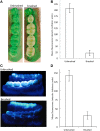Visualization and Quantification of the Oral Hygiene Effects of Brushing, Dentifrice Use, and Brush Wear Using a Tooth Brushing Simulator
- PMID: 31192180
- PMCID: PMC6517784
- DOI: 10.3389/fpubh.2019.00091
Visualization and Quantification of the Oral Hygiene Effects of Brushing, Dentifrice Use, and Brush Wear Using a Tooth Brushing Simulator
Abstract
Approaches that reproduce dental hygiene regimens under controlled conditions have applications in preclinical research. We have applied standardized, reproducible brushing regimes to typodonts coated in simulated or biological plaques to assess the effects on tooth cleaning of toothbrush/dentifrice regimens. Replicated typodonts were coated with OccludeTM or GlogermTM indicators to simulate plaque, and brushed reproducibly using a mechanical brushing simulator to compare the cleaning of occlusal surfaces before and after brushing with water or a dentifrice. An in vitro model using salivary inocula to cultivate oral biofilms on typodont surfaces was then developed to evaluate removal of disclosed plaque by new toothbrushes in comparison to toothbrushes with wear equivalent to 3 months of use. Analyses of typodonts brushed under controlled conditions significantly (p < 0.01) distinguished between brushed and unbrushed surfaces and between the use of water vs. dentifrice for the removal of simulated interproximal plaque (p < 0.05). New toothbrushes removed significantly (p < 0.05) more biological plaque from typodont surfaces than brushes that had been worn by repeated brushing. Through controlled and defined brushing of typodonts with simulated and biological plaques, the effectiveness of dental hygiene regimens was compared under reproducible conditions. Data indicate that the cleaning effectiveness of brushing was augmented by the addition of dentifrice and that new brushes were significantly more effective than brushes with substantial wear from previous use. Whilst we have focussed on the occlusal surfaces of molars and worn brushes, the method could be applied to a range of other tooth surfaces and oral hygiene regimens.
Keywords: biofilm model simulated plaque; brush wear; brushing simulator; dental plaque; typodont.
Figures





Similar articles
-
Robot and mechanical testing of a specialist manual toothbrush for cleaning efficacy and improved force control.BMC Oral Health. 2022 Jun 8;22(1):225. doi: 10.1186/s12903-022-02211-4. BMC Oral Health. 2022. PMID: 35676648 Free PMC article.
-
Comparative Analysis of Plaque Removal and Wear between Electric-Mechanical and Bioelectric Toothbrushes.Bioengineering (Basel). 2024 May 9;11(5):474. doi: 10.3390/bioengineering11050474. Bioengineering (Basel). 2024. PMID: 38790341 Free PMC article.
-
Plaque-removing efficacy of new and used manual toothbrushes--a professional brushing study.Int J Dent Hyg. 2013 Nov;11(4):237-43. doi: 10.1111/idh.12021. Epub 2013 Mar 18. Int J Dent Hyg. 2013. PMID: 23506005 Clinical Trial.
-
Plaque removal efficacy of oscillating-rotating power toothbrushes: review of six comparative clinical trials.Am J Dent. 2013 Apr;26(2):68-74. Am J Dent. 2013. PMID: 24073528 Review.
-
Mechanical plaque removal in step-1 of care.Periodontol 2000. 2023 Dec 26. doi: 10.1111/prd.12541. Online ahead of print. Periodontol 2000. 2023. PMID: 38148481 Review.
Cited by
-
Changes in the Bristle Stiffness of Polybutylene Terephthalate Manual Toothbrushes over 3 Months: A Randomized Controlled Trial.Materials (Basel). 2020 Jun 22;13(12):2802. doi: 10.3390/ma13122802. Materials (Basel). 2020. PMID: 32580300 Free PMC article.
-
New experimental setup for the measurement of cleaning efficacy and force of interdental aids in 3D-reproduced interdental areas.BMC Oral Health. 2020 May 8;20(1):136. doi: 10.1186/s12903-020-01129-z. BMC Oral Health. 2020. PMID: 32384897 Free PMC article.
-
A commercial SnF2 toothpaste formulation reduces simulated human plaque biofilm in a dynamic typodont model.J Appl Microbiol. 2022 Sep;133(3):1341-1352. doi: 10.1111/jam.15634. Epub 2022 Jun 5. J Appl Microbiol. 2022. PMID: 35603698 Free PMC article.
-
Bristle splaying and abrasive potential of different toothbrushes on the enamel and resin composite after brushing simulation.J Clin Exp Dent. 2025 Mar 1;17(3):e259-e267. doi: 10.4317/jced.62585. eCollection 2025 Mar. J Clin Exp Dent. 2025. PMID: 40231134 Free PMC article.
-
Robot and mechanical testing of a specialist manual toothbrush for cleaning efficacy and improved force control.BMC Oral Health. 2022 Jun 8;22(1):225. doi: 10.1186/s12903-022-02211-4. BMC Oral Health. 2022. PMID: 35676648 Free PMC article.
References
LinkOut - more resources
Full Text Sources

